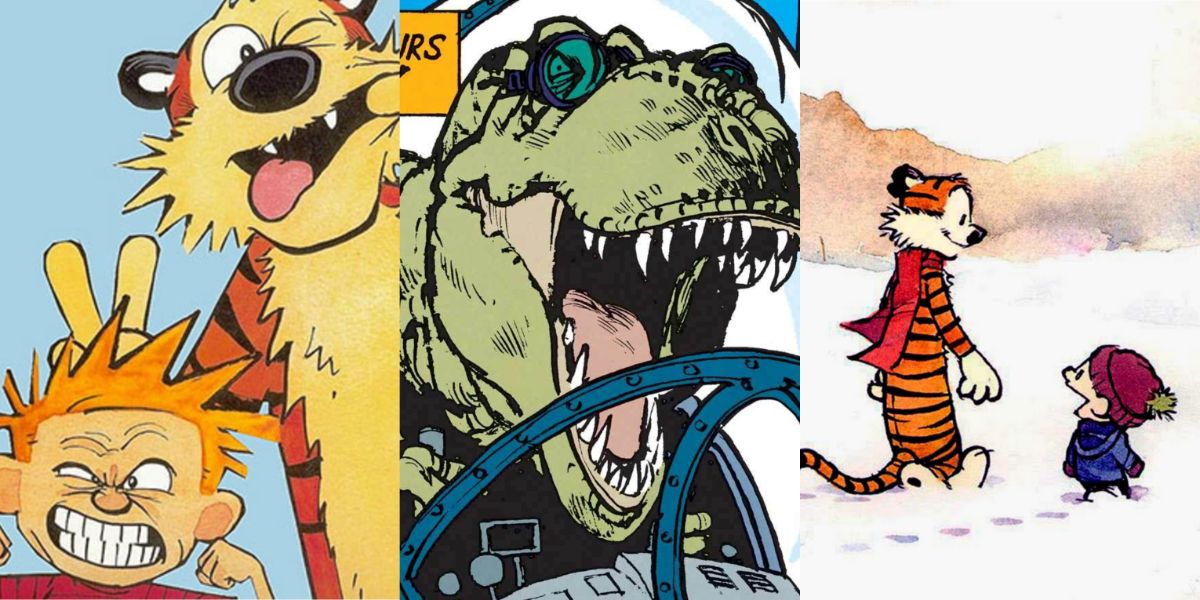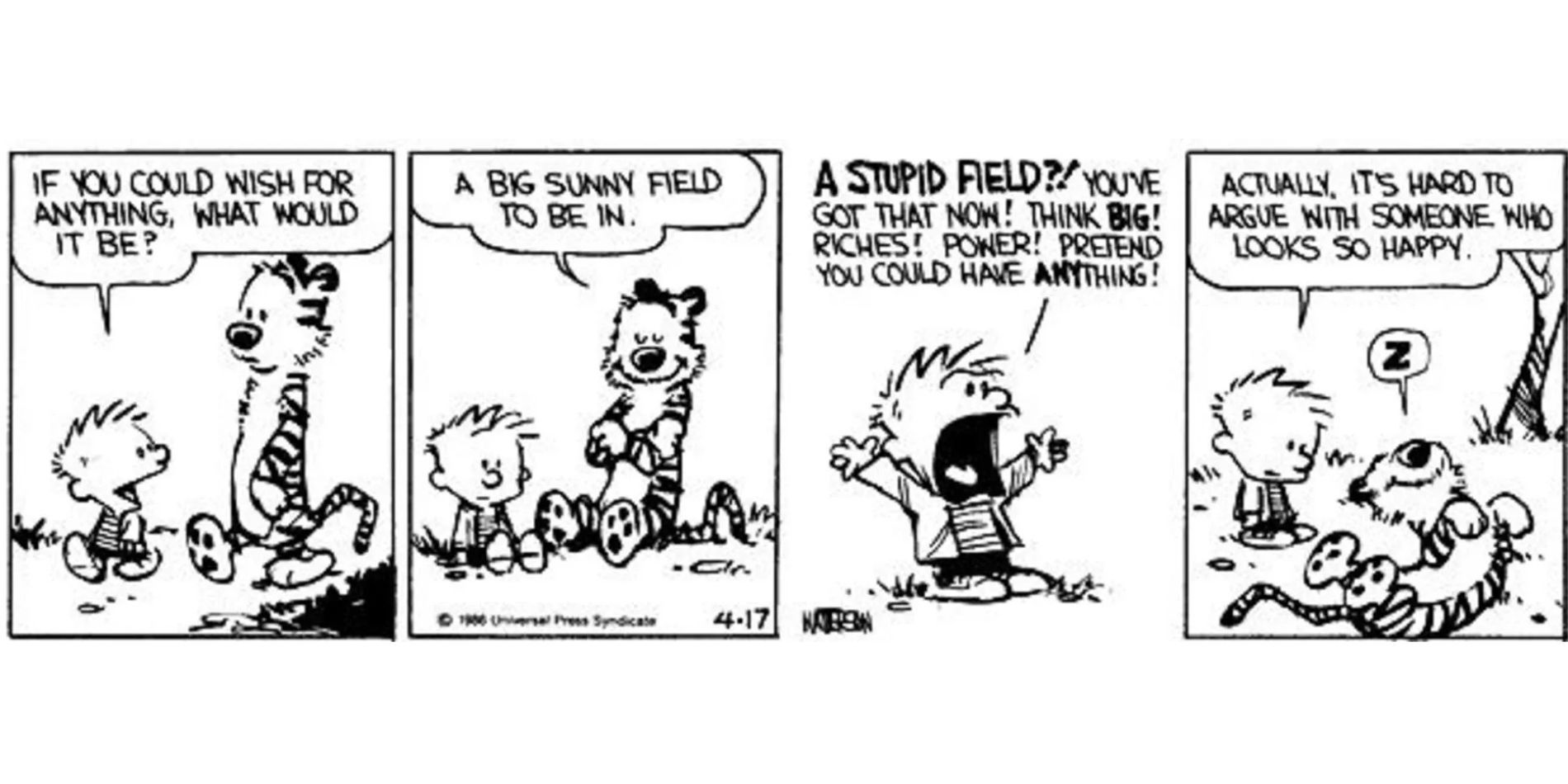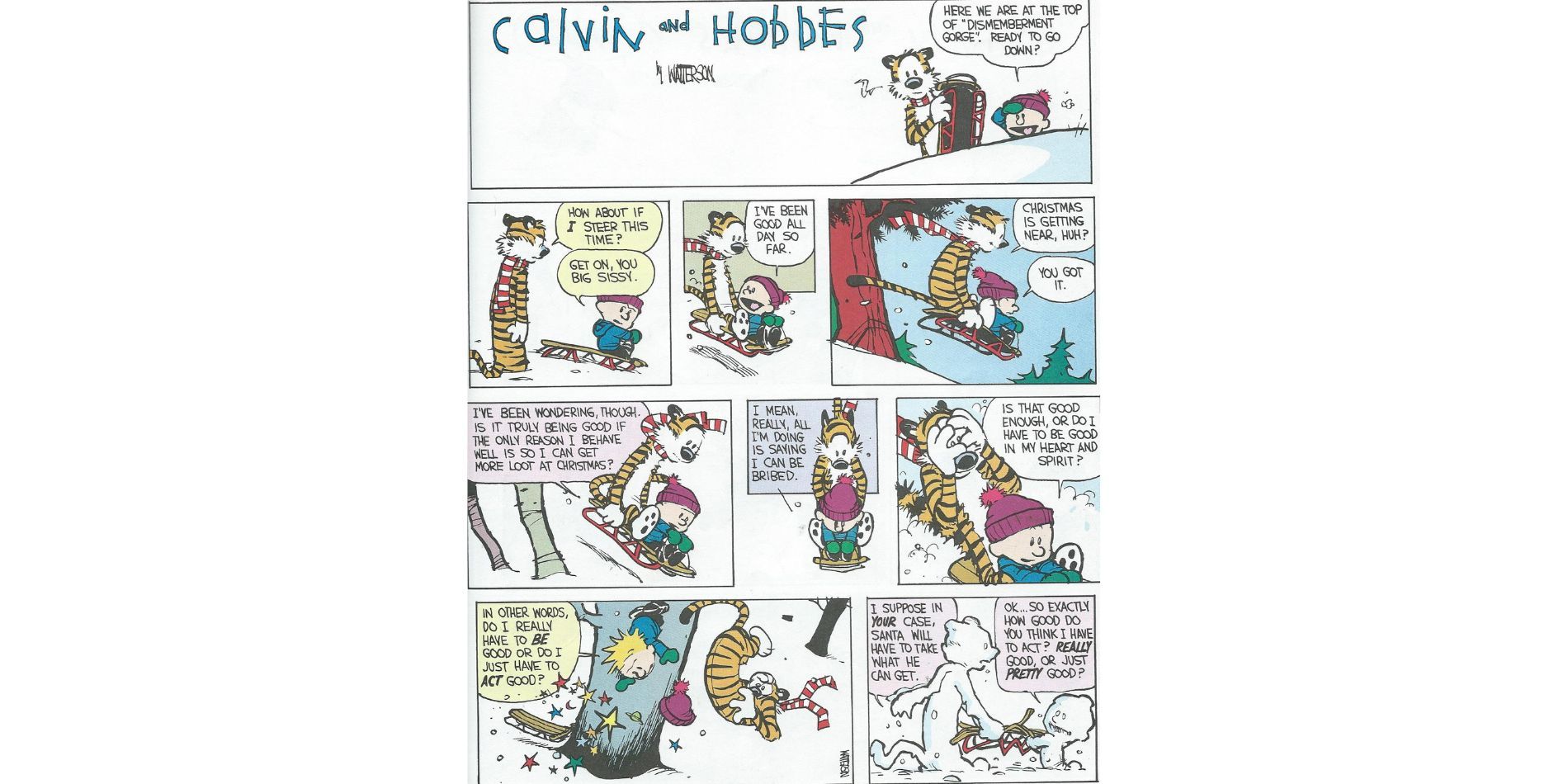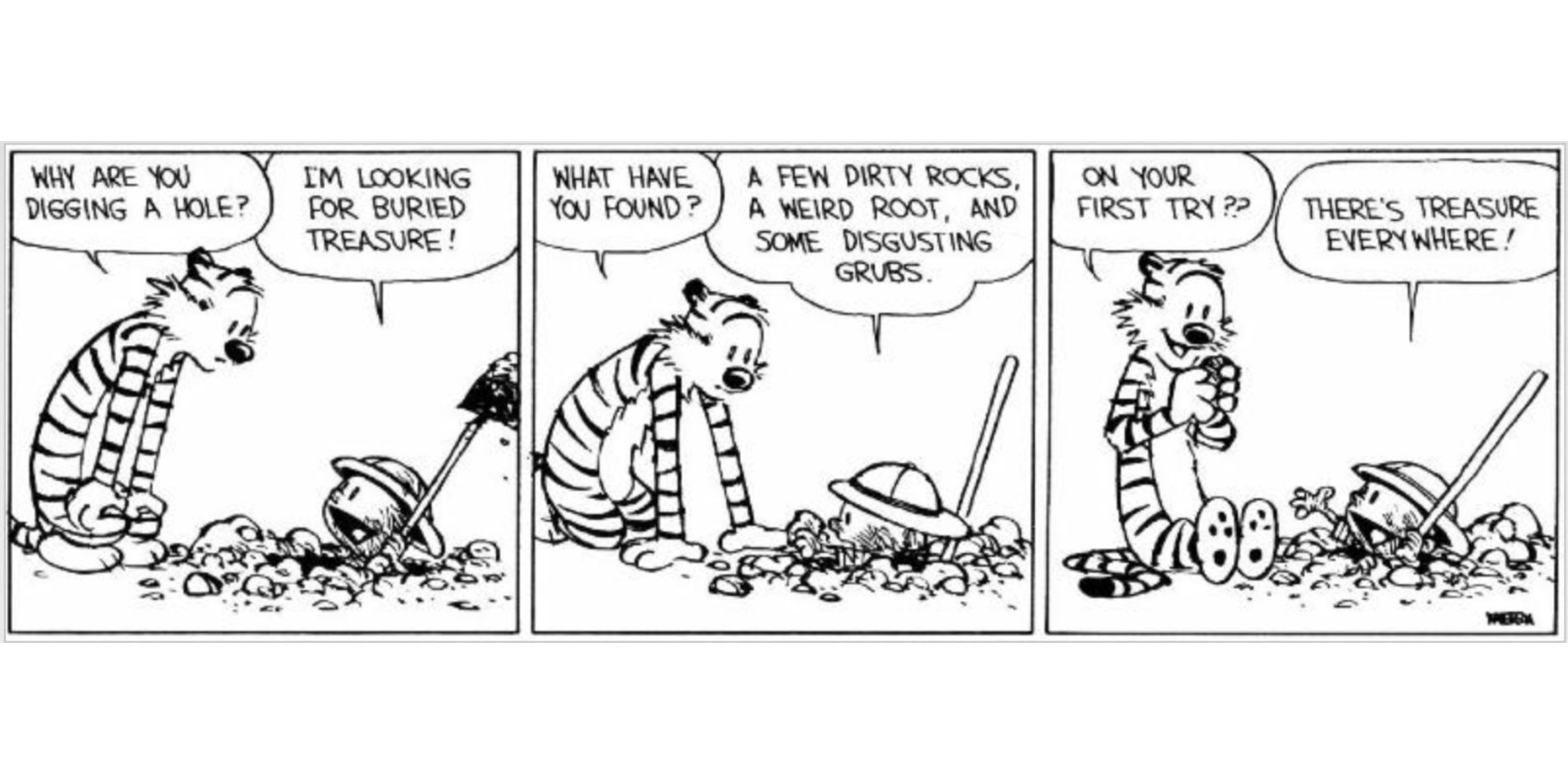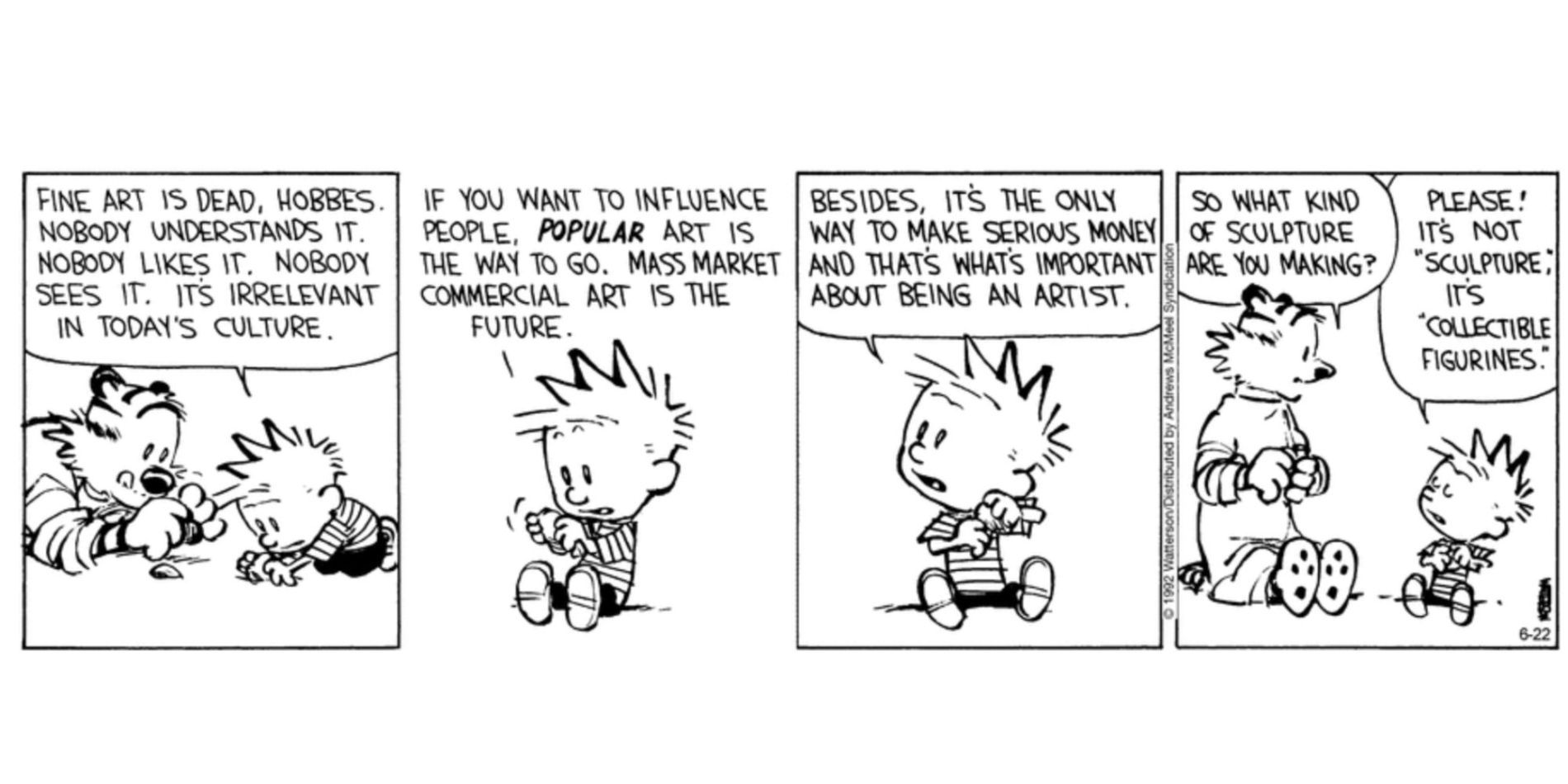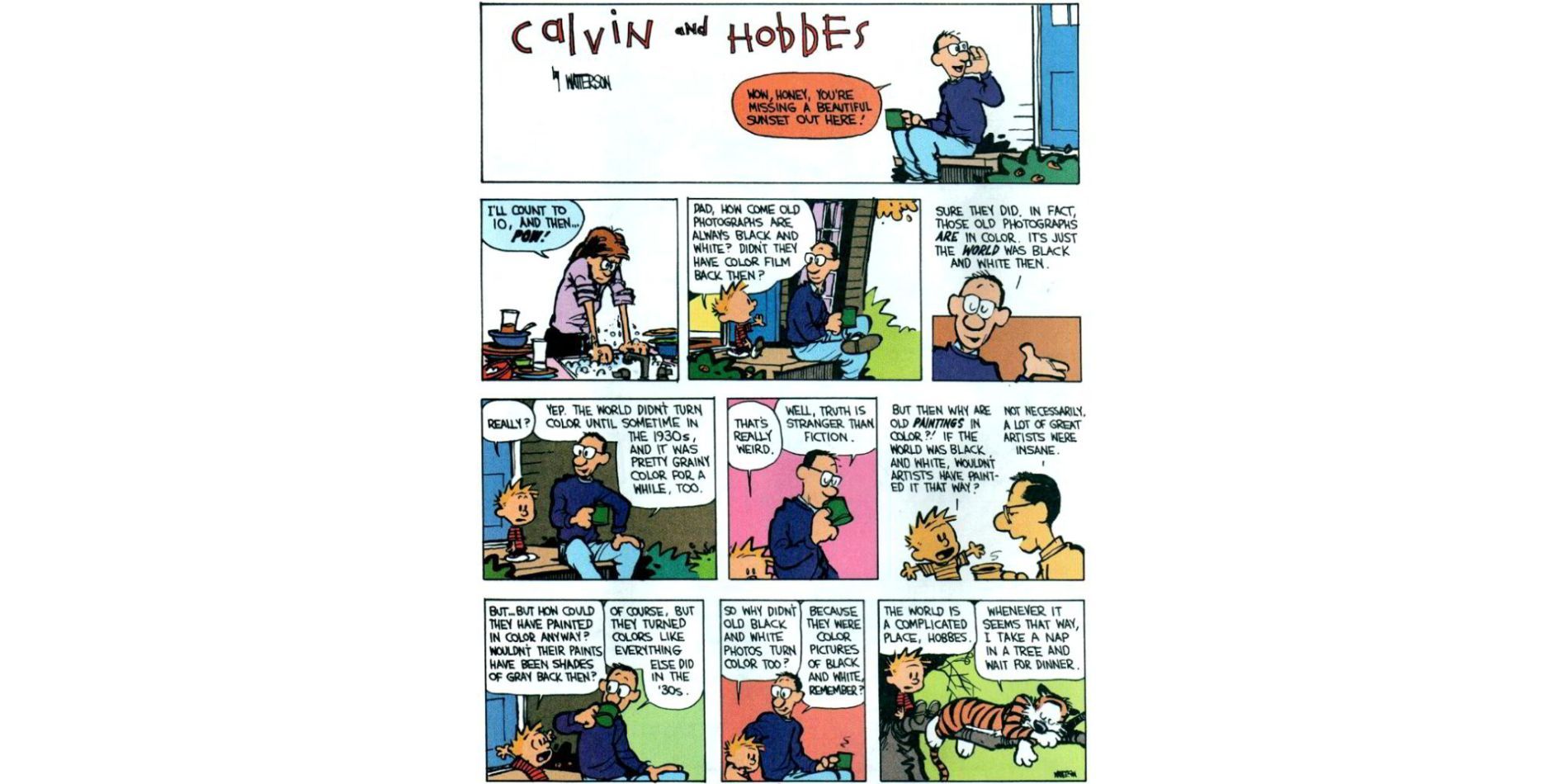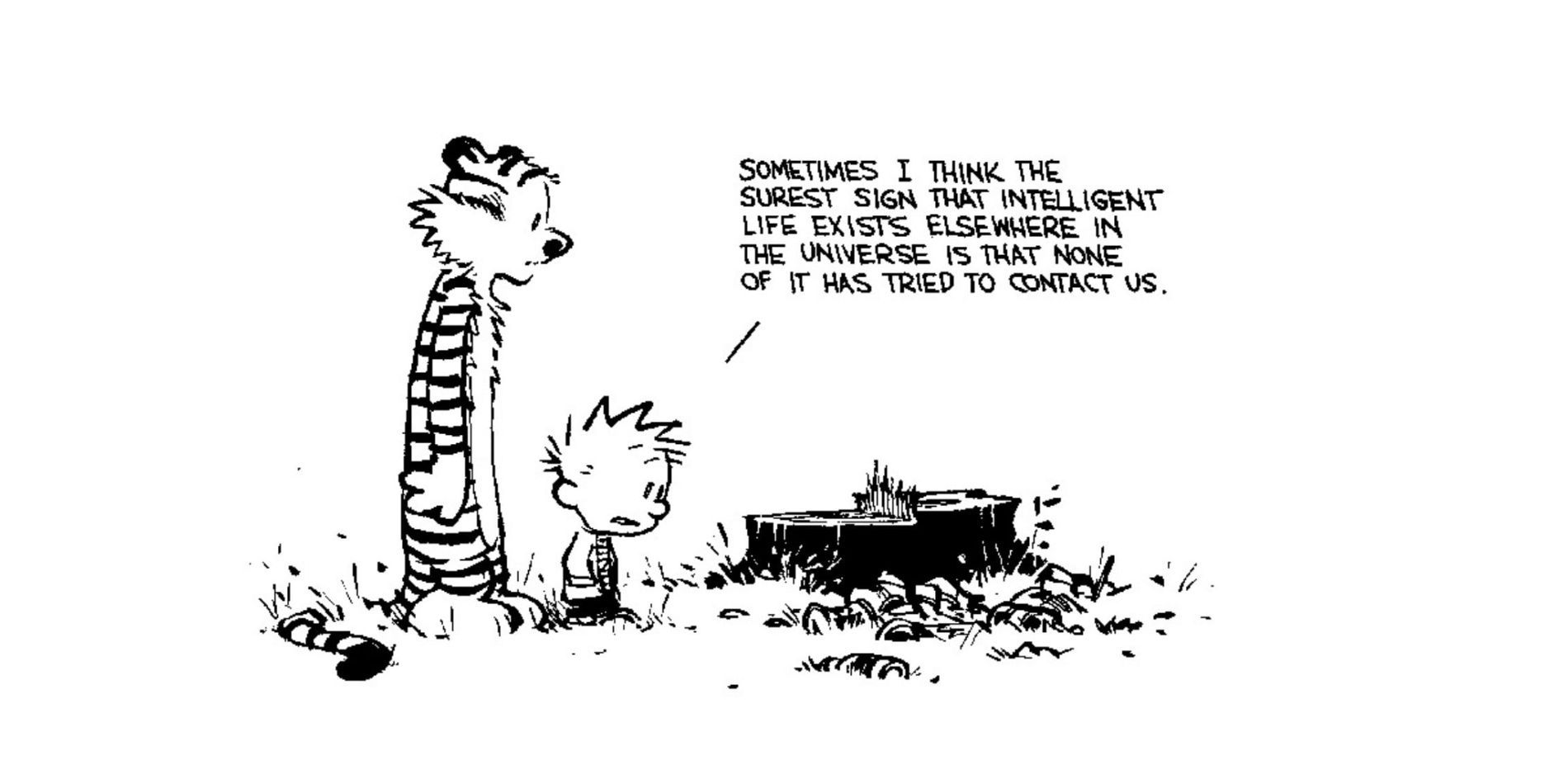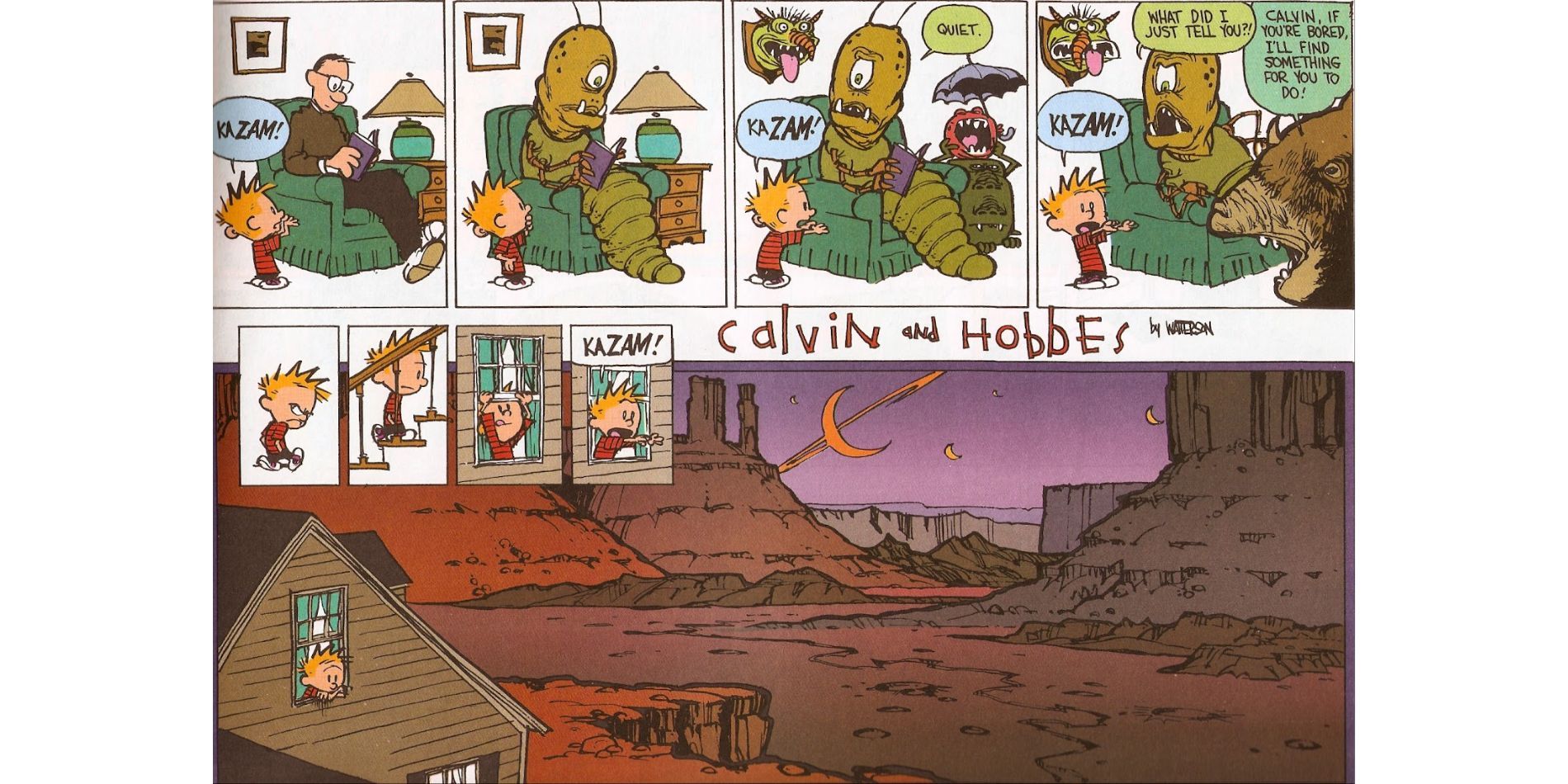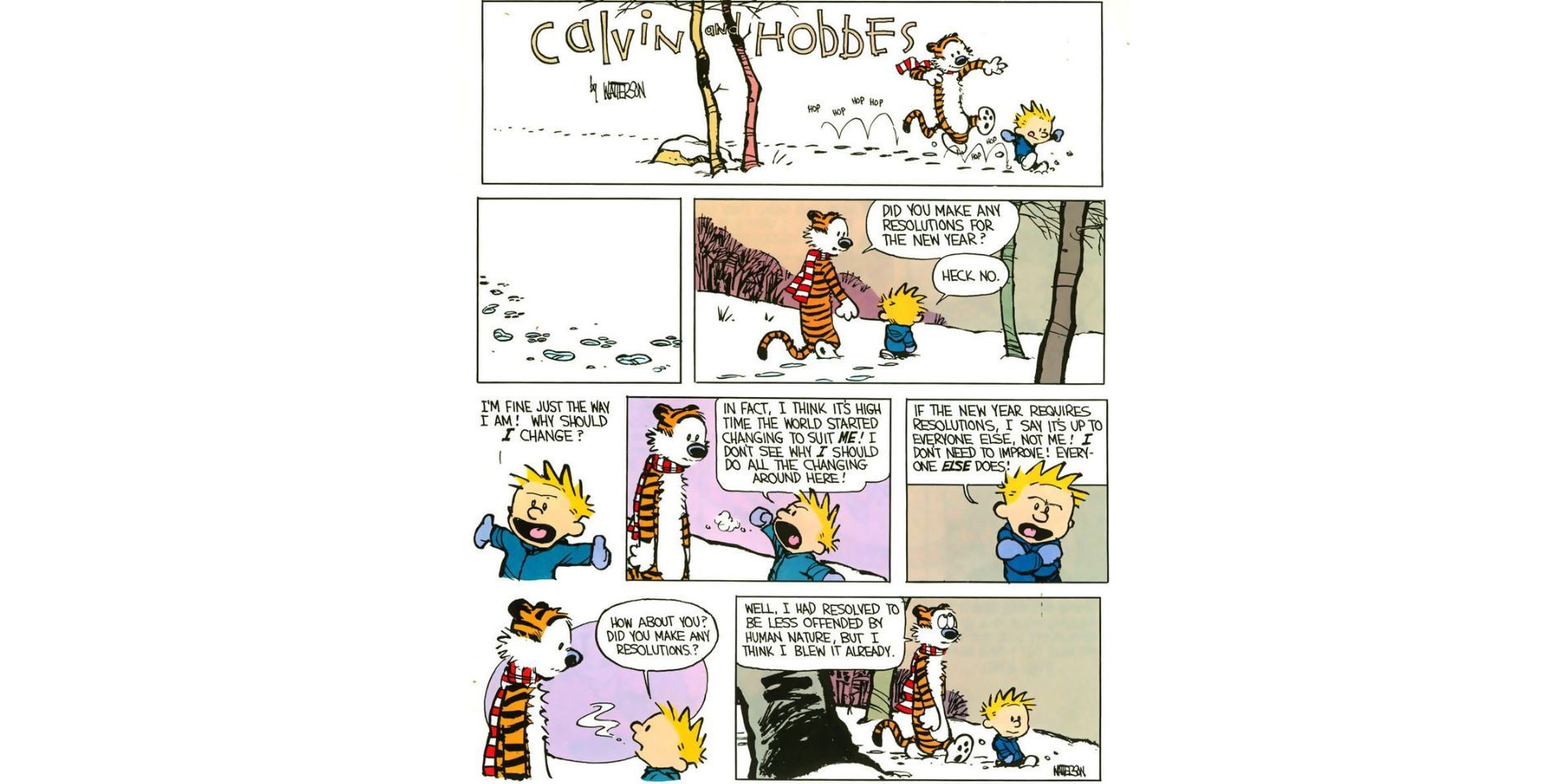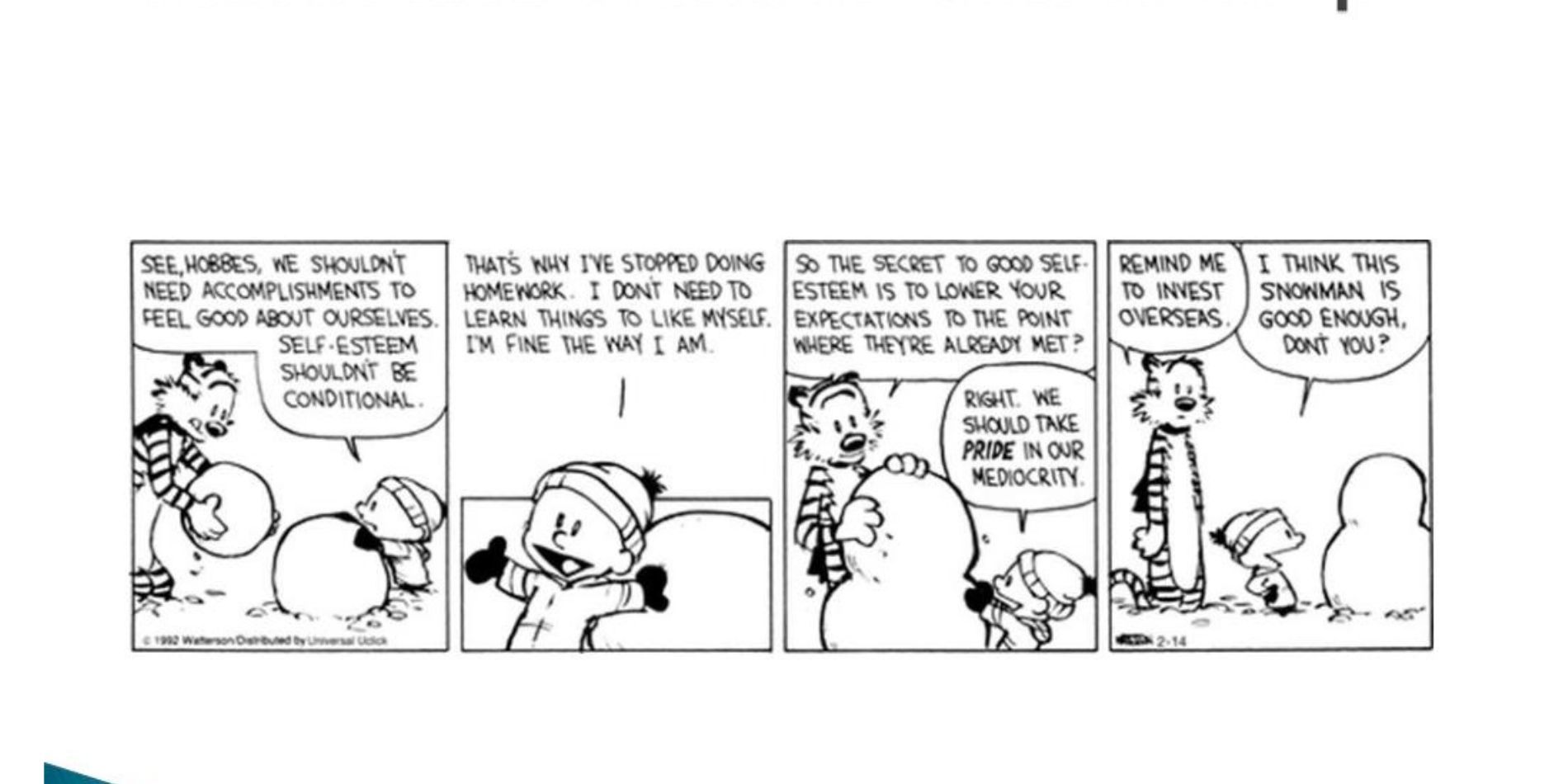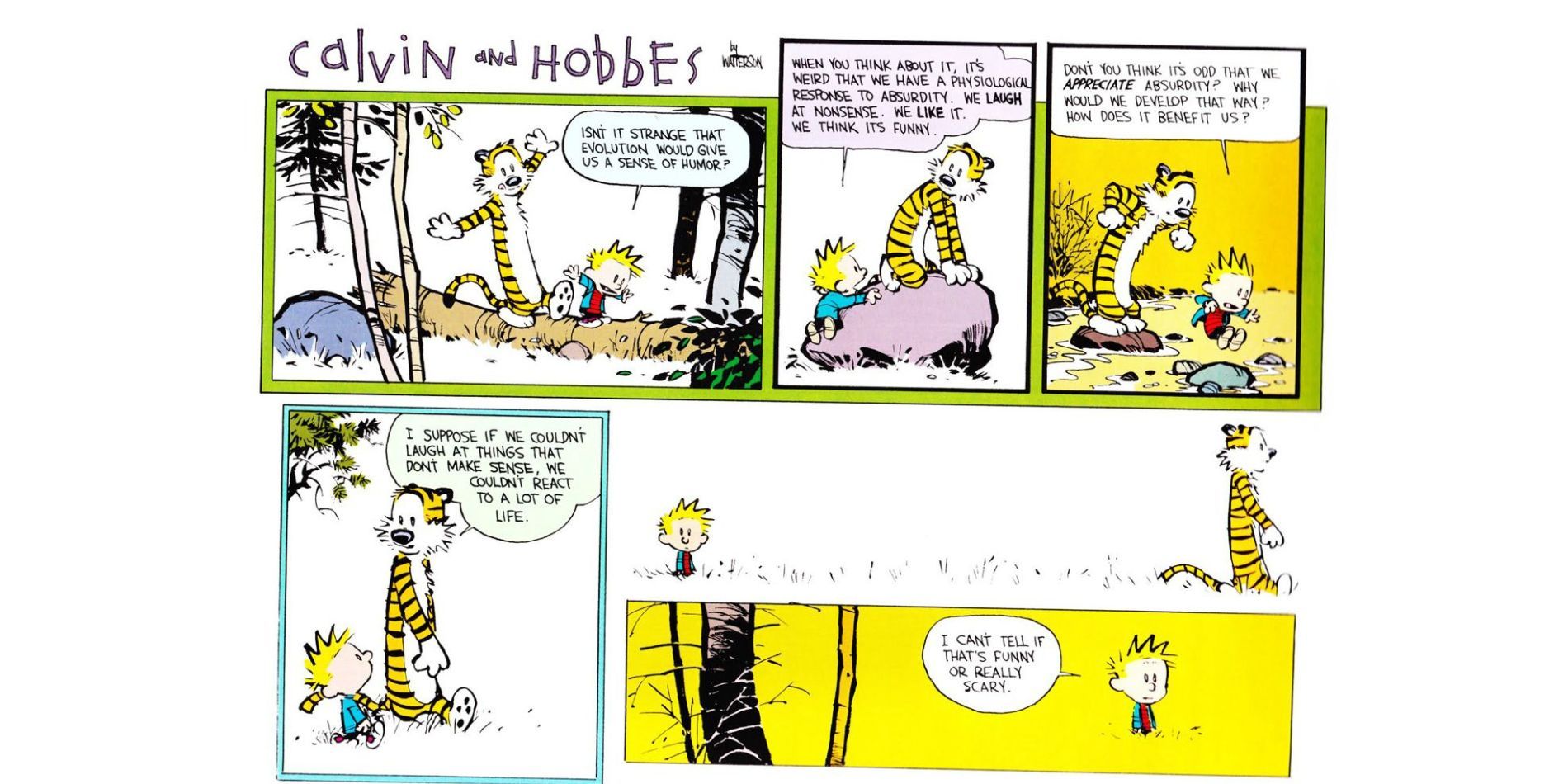Bill Watterson's Calvin and Hobbes has delighted fans of all ages since its first syndicated appearance. November 18th marks the 37th anniversary of the comic strip and the impact and legacy of the long-running series are as strong as ever. Calvin and Hobbes is a complete work of art that not only tested the boundaries of the comic panels themselves but tested what audiences would be able to comprehend in a format that was usually reserved for quick, punchy jokes.
Watterson's comics dealt with themes of environmentalism, philosophy, and art, and stayed humorous the whole time. Calvin and Hobbes comics could lull one with stories about killer snowmen and cardboard boxes and then surprise with deeper discussions about the nature of humanity.
A Stupid Field!?
Calvin and Hobbes often spend their time together discussing hypothetical questions and then inevitably arguing about why their respective answers are wrong. In this comic, Calvin's materialism is contrasted with Hobbes' animalistic pursuit of rest and relaxation. Calvin is always on the lookout for ways to get money and power, he is a bit of a Napoleon with a soft side.
So when Hobbes says he would ask for a field, Calvin can hardly believe it. But after one look at the sleeping, content tiger, even Calvin has to admit that it sounds like a pretty good wish. As vocal as he can be about his views, Calvin is willing to change them when a compelling argument is made.
Dismemberment Gorge
Bill Watterson had the Calvin and Hobbes comics follow the same seasonal changes as the real world, so his famous sledding and Christmas strips would tend to line up with the United States calendar. These comics would usually show Calvin trying to figure out how he would be getting presents that year, despite being a self-confessed menace.
In this strip, he has a one-sided conversation about how good he will need to be this year to earn presents from Santa. In their race down a dangerous mountain, Calvin ponders if one can be truly good if they're only acting that way to receive a material reward. It's a deep and difficult question about the nature of morality, but it's hidden by the fact that Calvin is mostly just interested in changing exactly how good of a person he needs to be in order to get some gifts.
There's Treasure Everywhere!
One of the most endearing aspects of Calvin and Hobbes is that while the two are often at odds, arguing about one thing or another, they are kindred spirits all the same. When Calvin digs up a bunch of grubs and worms, both he and his tiger see the haul for what it is, a bounty of riches.
The punchline of the joke isn't just a fun way to show that the two friends are delighted by the same mundane objects. It is also an important message about real riches, a theme present in many of Watterson's strips. Perhaps the duo doesn't know what a real treasure looks like, but it might be more accurate to say that many people refuse to see the world around them for the treasure it is.
Fine Art Is Dead, Hobbes
Bill Watterson had such a critical eye on society and such a unique viewpoint that it was inevitable that the truths he told in the 80s and 90s would still be accurate years later. For instance, this strip of Calvin discussing the death of real art and how only mass-produced pop art is worth anything in this day and age.
Using the characteristic impossibly good diction of Calvin, Watterson uses a joke about a get-rich-quick scheme to make a point about the commercialization of his own art and the industry in general. The punchline about collectible figurines and art to make money could be written in today's newspaper as a reference to Harry Potter Funko Pops and Bored Ape NFTs.
The World Didn't Turn Color Until Sometime In The 1930s
Whenever there is a comic strip of Calvin asking his dad a question, it's guaranteed that dad is going to use the chance to tell a long-winded lie that confuses and/or infuriates Calvin. In this Sunday strip, Calvin's confusion about black-and-white photos is just made worse by his dad's answers, who seems to have a counter for every one of his follow-ups.
Hobbes responds to Calvin's confusion with characteristic indifference, and it poses an interesting philosophical quandary to the reader. Is it better to explore the strangeness of the world and become wrapped up in solving it or would one be best served behaving like Hobbes, taking a nap and grabbing something to eat instead of wasting time on the unknown.
Surest Sign Of Intelligent Life
Bill Watterson has very strong views on the impact humans have had on nature. He used both Calvin and Hobbes as mouthpieces to talk about issues he has with industry and some of these more dour comics, while beautifully drawn, are anything but funny.
This one-panel comic shows Calvin and Hobbes staring despondently at a cut tree, a sign of industrialization, and Calvin poignantly notes that no species would ever want to contact humanity, considering how they treat their own world. There is another layer of melancholy because Calvin is always imagining aliens so to have him conclude they don't exist is particularly heartbreaking.
KAZAM!
Due to the success of Calvin and Hobbes, Bill Watterson was able to gain an unusual amount of creative control over his comics. This allowed Watterson to make Sunday strips that did not adhere to the usual panel guidelines, which let him explore unique formats with his art.
In this Sunday comic, Watterson's art takes center stage in a rendition of Calvin's imagination. It's an accurate look into the mind of a child. Calvin, despite his penchant for mayhem, really just wants to be creative and tries many times to make others see the world the way he does. Watterson does an excellent job showing the beauty and melancholy loneliness that can come with a creative mind.
Why Should I Change?
Sometimes Calvin can be a hyper-intelligent philosopher about the human condition, and sometimes he can be a selfish and entitled brat. And whenever he gets too out of control, Hobbes is there to call him out either to his face or to the audience.
Hobbes asks whether Calvin has any New Year's resolutions and Calvin responds with a diatribe about he doesn't need to change, the world does. In response, Hobbes offers a subtle criticism of people saying how offensive and apparently characteristic that line of thinking is for humanity.
Remind Me To Invest Overseas
The frequent use of snowmen in Calvin and Hobbes does two things for Bill Watterson. It allows him a creative outlet to draw unusual illustrations, and it lets Watterson sound off on his problems with the art world and commodification.
In Calvin and Hobbes comics, it's always funny the way Calvin will completely tear apart the problems with modern society and then instead of despairing, actually revel in his insight. In this comic, Calvin decides it's better to lower ambitions and expectations, that way failure is avoided and people can get away with doing less, like only building half a snowman. Hobbes sees how that line of thinking in today's youths might lead to a decline in society in general.
We Laugh At Nonsense
A walk in the woods for Calvin and Hobbes is usually an excuse for them to ponder life's deeper questions. Calvin essentially questions his own existence, asking why people laugh, and the evolutionary benefit of such a trait. This would be a heavy question on its own but coming from a piece of art designed specifically for laughter, it's particularly heady.
Hobbes tells Calvin that laughter is the only answer to an unfathomable world, otherwise, people would not react at all. In other words, this world is so perplexing that to try and do anything but laugh would be a waste of time. This could be a comfort or a dreadful proposition depending on one's outlook and Calvin seems to be grappling with it even after the comic ends.

